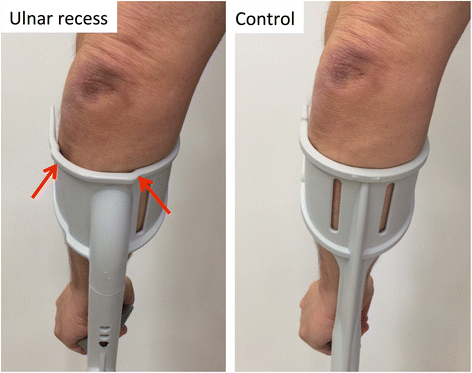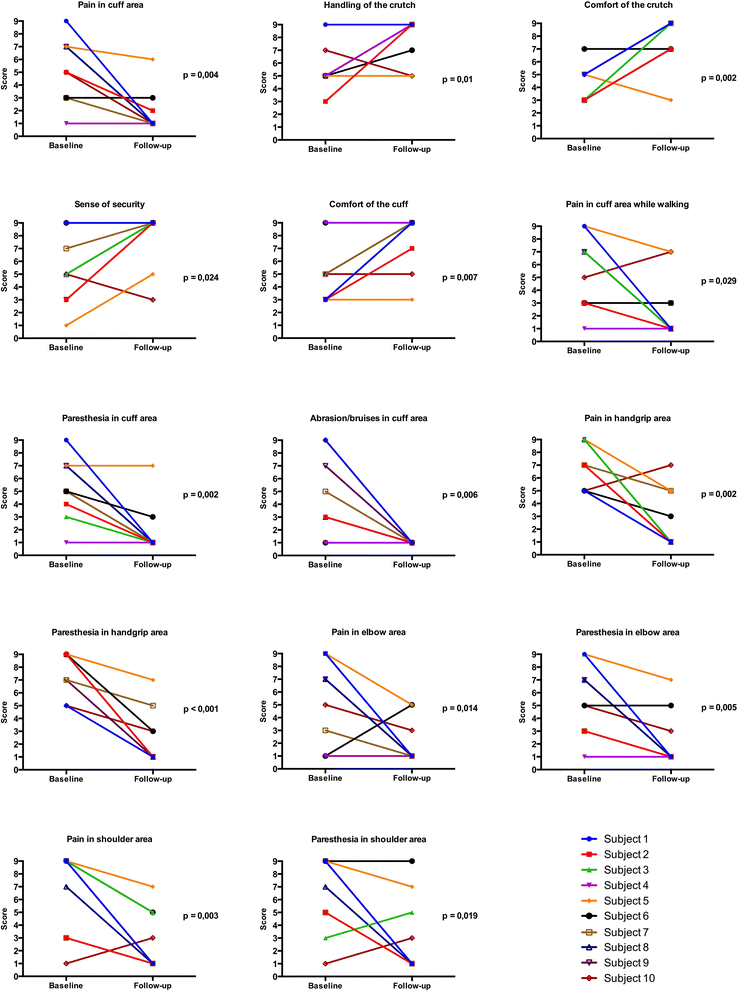Prospective clinical evaluation of a novel anatomic cuff for forearm crutches in patients with osteoarthritis
- PMID: 28292295
- PMCID: PMC5351049
- DOI: 10.1186/s12891-017-1459-7
Prospective clinical evaluation of a novel anatomic cuff for forearm crutches in patients with osteoarthritis
Abstract
Background: The use of forearm crutches has been associated with pain and neuropraxia along the ulnar bone. Whilst anatomic grips have improved comfort of crutch walking, to date anatomic forearm cuffs have not been clinically evaluated. The aim of this clinical pilot study was to determine if the use of forearm crutches with anatomic cuffs reduces pain and increases comfort and function in long-term users of forearm crutches during a 4-week period.
Method: Prospective study in ten patients suffering from end-stage osteoarthritis of the lower extremity. All participants were long-term users of conventional forearm crutches. Participants used forearm crutches with an anatomically shaped cuff for 4-weeks. General health was assessed using the SF-36, and the crutches were evaluated using a newly developed questionnaire focusing on symptoms along the forearm.
Results: Pain and paresthesia along the forearms decreased by 3.3 points (95% confidence interval difference (CI): [-5.0; -1.6], p = .004) and 3.5 points (95%CI: [-5.1; -1.9], p = .002), respectively, after using the crutches with the new anatomic cuff for 4 weeks. Comfort and sense of security of crutch use increased by 3.0 points (95%CI: [1.3; 4.7], p = .007) and 2.4 points (95%CI: [0.7; 4.1], p = .024). Cross-correlation analysis revealed correlations among items in the same item category and no correlations between items of different item categories of the new questionnaires.
Conclusion: An anatomically shaped cuff increases comfort of forearm crutches. Further research should confirm long-term clinical improvement.
Trial registration: This study was registered retrospectively in ISRCTN (TRN: ISRCTN 11135150 ) on 14/02/2017.
Keywords: Comfort; Crutch design; Crutches; Pain; Walking.
Figures




Similar articles
-
Reduction in ulnar pressure distribution when walking with forearm crutches with a novel cuff design: Cross-sectional intervention study on the biomechanical efficacy of an ulnar recess.Assist Technol. 2018;30(1):34-38. doi: 10.1080/10400435.2016.1236045. Epub 2016 Oct 27. Assist Technol. 2018. PMID: 27717292
-
Forearm pressure distribution during ambulation with elbow crutches: a cross-sectional study.J Neuroeng Rehabil. 2014 Apr 15;11:61. doi: 10.1186/1743-0003-11-61. J Neuroeng Rehabil. 2014. PMID: 24731773 Free PMC article.
-
The Effect of a Shock Absorber on Spatiotemporal Parameters and Ground Reaction Forces of Forearm Crutch Ambulation.Assist Technol. 2015 Winter;27(4):257-62. doi: 10.1080/10400435.2015.1045997. Assist Technol. 2015. PMID: 26151882
-
Injuries Associated with Crutch Use: A Narrative Review.PM R. 2021 Oct;13(10):1176-1192. doi: 10.1002/pmrj.12514. Epub 2020 Dec 8. PM R. 2021. PMID: 33094912 Review.
-
Walking assistance using crutches: A state of the art review.J Biomech. 2020 Jan 2;98:109489. doi: 10.1016/j.jbiomech.2019.109489. Epub 2019 Nov 14. J Biomech. 2020. PMID: 31831139 Review.
References
-
- Kaye HS, JKang T, LaPlante MP. Mobility device use in the United States. In: Research NIoDaR, editor. Disability Statistics Report 2000
-
- Vos T, Flaxman AD, Naghavi M, Lozano R, Michaud C, Ezzati M, Shibuya K, Salomon JA, Abdalla S, Aboyans V, et al. Years lived with disability (YLDs) for 1160 sequelae of 289 diseases and injuries 1990–2010: a systematic analysis for the global burden of disease study 2010. Lancet. 2013;380:2163–96. doi: 10.1016/S0140-6736(12)61729-2. - DOI - PMC - PubMed
-
- Fisher SV, Patterson RP. Energy cost of ambulation with crutches. Arch Phys Med Rehabil. 1981;62:250–6. - PubMed
MeSH terms
Associated data
LinkOut - more resources
Full Text Sources
Other Literature Sources
Medical

